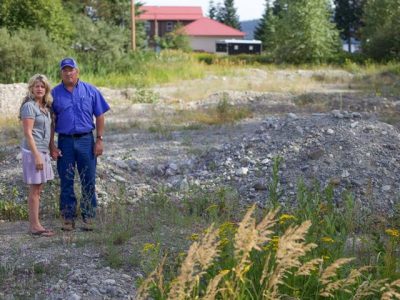On the First Monday in October, the Sacketts Head to the Supreme Court a Second Time
Sackett v. EPA–the Most Important Environmental Case on the Justices’ Current Docket–Will Answer the Key Question of How Far Federal Wetlands Regulation Extends Under the Clean Water Act

Today the U.S. Supreme Court formally begins its 2022-23 Term. First up on the justices’ docket this morning is a major environmental case: Sackett v. Environmental Protection Agency, No. 21-454.
This year marks the 50th anniversary of the Clean Water Act (CWA). Over the past half-century, no single CWA issue has proven more contentious and difficult to resolve than determining the extent of the nation’s waters that are subject to CWA permit jurisdiction. That issue occasionally arises regarding CWA section 402 (water pollution control) permit jurisdiction. But virtually all of the political debate and most of the litigation have concerned the parallel question of what constitutes “waters of the United States” under a separate CWA provision–section 404–by which USEPA and the U.S. Army Corps of Engineers jointly regulate the proposed “dredging and filling” of America’s wetlands.
After decades of controversy and conflicting lower court decisions, the Supreme Court appears poised to provide a definitive answer to this long-running wetlands jurisdictional issue. All signs point to the justices ruling in favor of the Sacketts–and, in the process, adopting a rule significantly narrowing wetlands permit jurisdiction under the CWA.
In a previous Legal Planet post following the Court’s decision in January to take up the Sackett case, I provided a detailed summary of the long history of the legal battle between the Sacketts and federal regulators. That battle concerns the Sacketts’ attempt to develop their property without complying with section 404 wetlands permit requirements under the CWA. I won’t repeat that summary here.
For present purposes, suffice it to say that this is the Sacketts’ second trip to the Supreme Court in the very same litigation. Fully a decade ago, the justices ruled–in a unanimous decision authored by the late Justice Scalia–that the Sacketts are not required to pursue administrative remedies before challenging in court federal regulators’ demand that they seek and obtain a section 404 permit before developing their property.
So back to the lower federal courts went the Sacketts, determined to pursue their substantive claim that their property contains no wetlands subject to EPA permit jurisdiction under their relatively narrow reading of the CWA. Both the district court and the Ninth Circuit Court of Appeals ruled against them, upholding the government’s claim that development of their property requires a section 404 permit from the EPA. The Supreme Court granted the Sacketts’ petition to review the case last January.
The Sacketts, represented by the Pacific Legal Foundation, argue for a narrow construction of the federal government’s wetlands jurisdiction. Specifically, they contend that to be a “wetland” subject to CWA section 404 permit jurisdiction, the relevant parcel must satisfy a two-part test: 1) the wetland must have a continuous surface connection with a “water”; and 2) that the “water” to which the wetland is continuously connected must be an established stream, ocean, river or lake. This construction is based and builds upon Justice Scalia’s 2006 plurality opinion in another major Supreme Court wetlands decision, Rapanos v. United States.
EPA, represented by the U.S. Department of Justice, argues that “wetlands” for purposes of the CWA should be defined more broadly than the Sacketts’ “physical nexus” standard. In doing so, the government adopts the concurring opinion in Rapanos authored by former Justice Anthony Kennedy. There, Kennedy proposed a more expansive jurisdictional standard: that for CWA Section 404 purposes, a wetland must simply have a “significant nexus” to a navigable waterway, or one that could reasonably be made navigable. Many lower courts around the nation have embraced and applied the Kennedy “significant nexus” standard in CWA section 404 cases. Indeed, that’s exactly what the Ninth Circuit Court of Appeals did in ruling against the Sacketts below.
It seems to this observer that the Supreme Court stands poised to rule in favor of the Sacketts and against the federal government in this critically important CWA case.
There are several reasons for this assessment: first and most obviously, the Supreme Court has shifted dramatically rightward–as the justices’ voting record in its 2021-22 Term attests. Focusing specifically on the central issue in Sackett, it’s noteworthy that none of the four justices who voted (in dissent) in Rapanos to support an even more expansive definition of section 404 wetlands jurisdiction than any of the parties are now advancing remain on the Court. Nor does Justice Kennedy, whose concurring opinion in Rapanos is the basis for the government’s legal position in Sackett. Meanwhile, all three of the conservative justices who joined in the late Justice Scalia’s 2006 plurality opinion in Rapanos are still on the Court. And a fourth current justice–Brett Kavanaugh–opined in a D.C. Circuit wetlands opinion that he agreed with the proposed Scalia wetlands standard.
All things considered, my crystal ball indicates that the justices are likely to vote … (wait for it) … 6-3 in favor of the Sacketts.
So perhaps the more pertinent question should be: just how broad or narrow will be the wetlands jurisdictional rule that the Supreme Court majority embraces. The answer to that question will have a profound impact on the future of America’s wetlands. The sad truth is that the vast majority of our nation’s wetlands have already been paved over or otherwise destroyed by human activity. (For example, 90% of California’s wetlands have been eliminated, as have fully 95% of its coastal wetlands.) Depending on how the Court rules in Sackett, that melancholy and alarming trend may well be perpetuated.
(Like several of my Legal Planet colleagues, I’ll be listening to today’s oral arguments in Sackett. [The Supreme Court has announced that live audio of the Court’s oral arguments this Term can be accessed via a direct link found on the Court’s official website.] I plan to post a follow-up summary and analysis of those arguments.)







Reader Comments